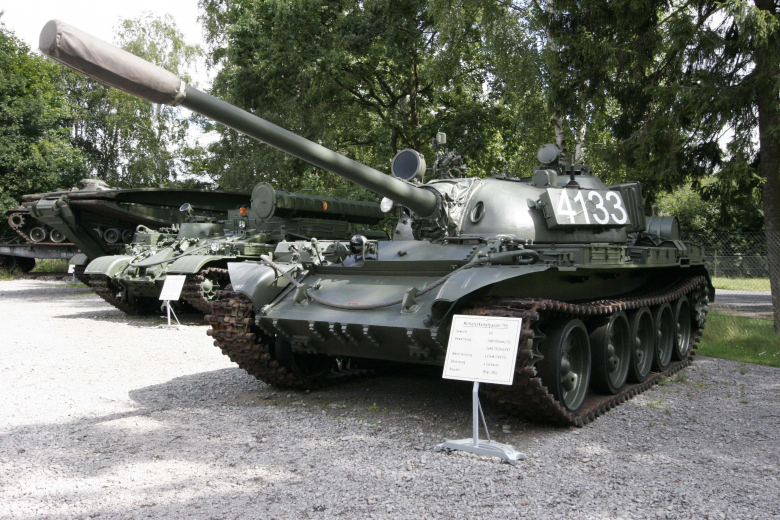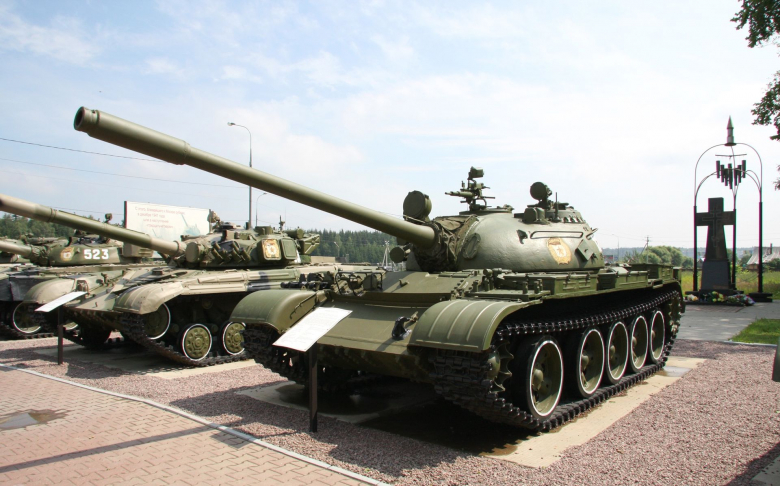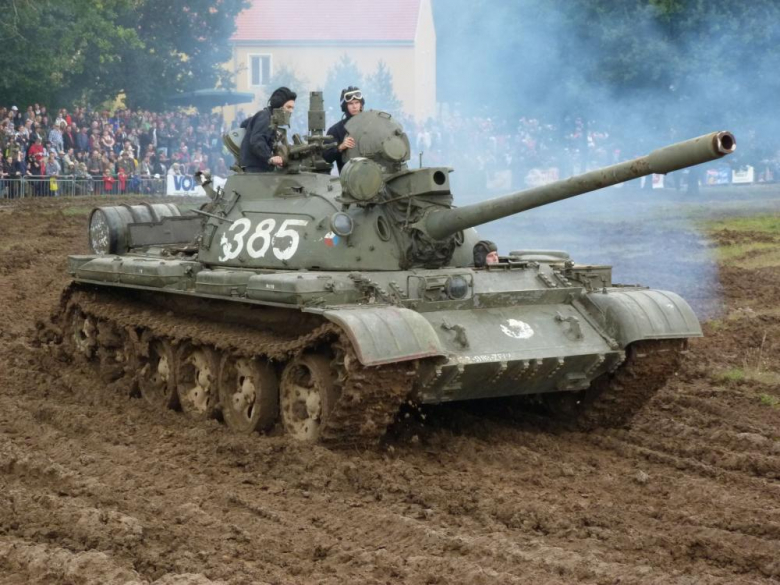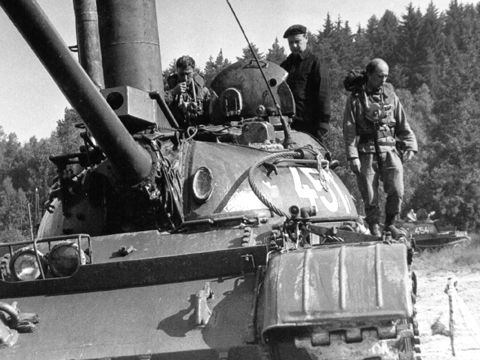
The T-54/55 series of Medium Tanks is, without a doubt, one of the most iconic tanks ever produced. Its iconic hemispherical turret and menacing shape were the nightmare of western strategists for the majority of the Cold War and the hordes of T-54/55 tanks that poured through the Fulda Gap were the subject of many a military publication.

T-55A, Panzermuseum Munster
However, while many perceive the vehicle as something typically Soviet and a symbol of Warsaw Pact military power, it is worth noting that other countries produced this particular type of tank.
Poland and Czechoslovakia (along with other small producers) were not only building, but also developing their own T-54s and T-55s, a program that resulted in perhaps two dozen different sub-types and prototypes ranging from basic T-54As to the most advanced types developed in the 1980s.
Covering them all in a single article is virtually impossible and in fact entire books have been written about T-54 development abroad. Thus, we will be focusing on the most advanced T-55 model actively deployed by Czechoslovakia and East Germany – the T-55AM1/AM2/AM2B series.
The background for the development of this series is identical to that of the T-55M series. T-54 production in Czechoslovakia ran from 1957 and T-55 production ran from 1964 until 1967. In 1967, T-55 production switched to T-55A. T-55A production ran until 1982.
Production numbers vary according to different sources – early estimates put the numbers at 687 T-55 and 3820 T-55A vehicles built in Czechoslovakia, but newer research indicates that the numbers were actually considerably higher because the previous estimates did not include tanks built specifically for export.

T-55A
V.Francev states that between 1964 and 1982, Czechoslovakia produced:
- 1129 T-55 (442 for export)
- 6299 T-55A (4883 for export)
- 902 T-55AK command version (807 for export).
The numbers above do not include specialized T-54/55 variants such as ARVs and armored bridgelayers. Tanks were an important Czechoslovak export item from the 1960s all the way to the 1980s.
The Czechoslovak T-55A had a number of improvements compared to the old T-55:
- Improved NBC protection by means of a special internal liner (as a result, the T-55A could be 200 meters closer to the epicenter of a tactical nuclear blast than a regular T-55 with the crew still surviving)
- Improved transmission (the clutch and gearbox became considerably sturdier)
- Improved track tension system and improved tracks with rubber-metal joints instead of just metal ones
- New compressed air-based emergency engine starter in addition to the old electrical one
- New hydraulics for the steering mechanism
- Improved fording elements
- Older R-113 radio replaced by the R-123 model
- Older R-120 intercom replaced by the R-124 model
- Coaxial 7.62mm SGMT machinegun replaced by a more modern PKT
And a few other minor changes. The fixed forward-aiming 7.62mm hull machinegun was removed on this model, but it received a new pintle-mounted 12.7mm DShK anti-aircraft machinegun.
At this point it's worth noting a few things. Not all Warsaw Pact tanks of the same designation were the same. The information available on the internet, in English or Russian, usually refers to the Soviet model of the tank. In the worst cases it is a mix of different sources that does not correspond to reality.
The T-55A represents one such example. The Soviet T-55A went through several stages of improvement that were not introduced to the license-produced T-55A until later, so a 1967 early production model of the Czechoslovak T-55A doesn't have the improved transmission while the Soviet one does. Other components were missing completely (for example, the Soviet NSV heavy machinegun was never installed on Czechoslovak T-55As).

T-55AM1
By the end of the 1970s, serving T-55As were (just like in Russia) becoming more and more obsolete. To increase their combat value, a new program was launched to develop an upgraded variant that would replace the aging T-55A production. The goals of the program were to:
- Enhance vehicle firepower for it to be able to defeat modern western tanks
- Enhance protection as much as possible
- Improve internal components such as the Fire Control System, fire extinguishers, communications and such
The program was divided into two stages. The first stage was called T-55AM1 and focused on improving firepower. The biggest change from the T-55A was the introduction of a Kladivo (Warhammer) Fire Control System, developed by Research Institute 060 in Prague (VÚ 060 Praha) between 1981 and 1983 (when development officially finished).
The system consists of:
- Laser rangefinder
- Electronic ballistic computer
- Operating terminal
- Power source
- Ammunition type selector
- Sensors
- Modified gunner sights
- Modified commander sights with target speed indicator
The ballistic computer was based on Czechoslovak-produced microprocessors. It collected data from 8 separate sensors automatically, with other data requiring manual input. The automatic sensor data input included tank speed, gun elevation, turret position, outside temperature, target vector etc.
Other data required manual input through the installed terminal keyboard. These included nominal shell muzzle velocity, weather and a few others.
Kladivo's laser rangefinder could measure targets at a distance of from 200 to 3900 meters. Its accuracy against enemy AFV front at 3500 meters was approximately 10 meters. At maximum distance, the targets had to be at least 30 meters apart for it to distinguish between them and measure accurately. When inactive, an electrically operated metal plate covered its optics. It was ready to measure within two seconds of activation and could be used 6 times per minute at most.

T-55AM1
Kladivo was also equipped with an electronic diagnostic system, indicating broken parts to the operator.
The performance increase was considerable. Accuracy (compared to the regular T-55A) was increased 6.4 times when firing while standing, 3.6 times when firing from short stops and 3 times when firing on the move. During training, regular military crews were able to hit 47.9 percent of targets with their first shot, which was 13.3 times more than using a regular T-55A.
The vehicle also received an SDIO laser designation warning indicator. The sensors covered 4 sectors. Each sector was 90 degrees wide and -15 to +45 degrees high. The measured wavelength ranged from 0.85 to 1.065 um, the maximum detectable distance of a 1MW laser was 5km.
However, introducing the Kladivo FCS and other components came at a cost. The weight of the vehicle increased by approximately 500kg and the amount of ammunition carried had to be reduced from 43 rounds to 38 rounds of the following composition:
- 18 HE rounds
- 4 AP rounds
- 6 HEAT rounds
- 10 APFSDS rounds
The vehicle probably carried AP and APFSDS rounds for economic reasons – simple AP works just as well against softer targets and large stocks of this ammunition were available since the earlier T-54/55 production.
The armor was unchanged from T-55 and T-55A, as was the engine (570hp V-55A four-stroke V12 diesel).
T-55AM1s were not built from scratch. Instead, from 1981 to 1985, a number of T-55A tanks was converted to the T-55AM1 standard at Repair Plant 025 in Nový Jičín (VOP 025).

T-55AM2
How many were converted to the T-55AM1 standard is unclear. We do know that the first 40 vehicles were delivered to the military in 1982 and approximately 1200 vehicles were converted to AM1 and AM2 standard. According to some sources there were approximately 450 T-55AM2s in total, leaving approximately 750 T-55As modernized to T-55AM1. This estimate is confirmed by the available pre-1989 official military counts: 760 modernized vehicles were reported as active at the end of 1985.
The T-55 tanks remained in Czechoslovak service until 2000 or so, when they were pulled back from service and (mostly) sold abroad.
T-55AM1s were not that widely exported. Several were sold to Cambodia in 1994 and a limited number was exported to Yemen between 1999 and 2000 (97 T-55 vehicles of various types). Some of those T-55AM1s were seen participating in the civil war raging there.
Czechoslovak T-55AM1s are usually eclipsed by the second stage of the upgrade program running from 1985, the T-55AM2/AM2B, which will be covered in a future article. Despite this, the T-55AM1 was a solid variant of the T-55 in its own right and should not be forgotten by history.








